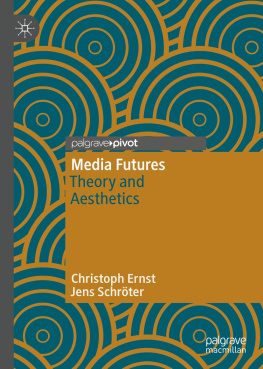
Contents
Jean-Michel Rabat, who has been professor of English and Comparative Literature at the University of Pennsylvania since 1992, is a co-founder and curator of Slought Foundation, an editor of the Journal of Modern Literature, and a Fellow of the American Academy of Arts and Sciences. He has authored or edited more than 30 books and collections on: modernism, psychoanalysis, and philosophy; and on writers like Samuel Beckett, Thomas Bernhard, Ezra Pound and James Joyce. In 2013, he edited A Handbook of Modernism Studies (Wiley-Blackwell). Forthcoming in 2014 are An Introduction to Literature and Psychoanalysis; A Companion to 1922; and The Value of Samuel Beckett.
Earlier versions of four chapters have been published in collections or reviews. All of these chapters have been revised and rewritten for this book.
A version of Chapter 2 was published as Theory: future, ancient, fugitive, in The Conditions of Possibility, Theory@buffalo, vol. 13, 2009, pp. 620.
A version of Chapter 5 was published as The Mujic of the Footure: future, ancient, fugitive, in Futures: Of Jacques Derrida, Richard Rand (ed.). Stanford: Stanford University Press, 2001, pp. 179200.
A section of Chapter 6 was published as The death of Freud: what is to be preferred, death or obsolescence?, in Qui Parle: Critical Humanities and Social Sciences, vol. 19, no. 1, 2010, pp. 3763.
A version of Chapter 8 was published as Crimes against fecundity: style and crime, from Joyce to Poe and back, in Style in Theory: Between Literature and Philosophy, Ivan Callus, James Corby and Gloria Lauri-Lucente (eds). London: Bloomsbury, 2013, pp. 11139.
I am grateful to the editors for granting permission to use these texts.
Originally, this books title was Theory of the Future. It was planned as a sequel to my 2002 book, The Future of Theory,
Hunger games
In that extraordinary first-person novel, a true precursor of Camus, Kafka and Becketta novel that should be mandatory reading in all high schools since it allows any young student to identify with a totally dispossessed, alienated, at times homeless and above all frantically hungry young manwe follow the narrator as he wanders through the streets of Oslo battling with poverty and near-starvation. His only source of revenue comes from the articles he manages to sell to newspapers, although most of the time he cannot write because he is too sick or delirious, subsisting on the sale of remaining possessions that he pawns one after the other. Among his projects of articles with which he intends to make money from newspapers is a recurrent project of writing an essay entitled Crimes of the Future. perhaps today, as a matter of fact, I would get an article started on Crimes of the Future (Fremtidens Forbrydelser) or Freedom of the Will, something like that, What I share with Hamsun, moreover, is the idea that anyone is capable of writing an essay on crimes of the future, provided ones hunger remains at the right level. The allusion to history books should suggest crimes of the past and not of the future; Hamsun knows very well that one understands the forthcoming crimes of the future by contemplating the annals of past crimes systematically consigned in chronicles and history books.
One of the most disturbing aspects of Hamsuns Hunger is that its main character looks like a criminalhe loiters in a distracted manner, follows cute women and addresses them with obnoxious remarks, he tells wild lies to strangers in parks, he is prone to hysterical fits, he spends nights in jail, etc.yet he never stoops so low as to commit a crime. The result is that it is the reader who wants him to be a criminal, a thief at least, if not necessarily a rapist. When he is obliged to chew on soft wood to assuage his pangs of hunger (he hasnt eaten for three days), we want to scream to him: Steal that loaf of bread! We would like him to become like Jean Genets alter ego in Diary of a Thief; even though Genet was hungry at times, these periods never lasted long, what with prostitution with older gay men whom he would then shake of their money, or downright burglaries. In fact, Hamsuns hero is entangled in bourgeois respectability to such a point that readers cannot help criticizing it while admiring the excess of his masochistic heroism.
Yet, if we take the idea of crimes of the future seriously, we guess why this topic comes to the imagination of a frantic, hallucinating would-be writer wildly spinning away from conventional modes of living. Hamsuns hero tackles a notion that has to do with the long-term historical evolution of two genres, one that could be called the poetics of modernity, the other the genre of the detective fiction. They had merged earlier, in the middle of the tenth century, and were theorized jointly half-a-century later, after Hamsun had been awarded the Nobel Prize in 1920. At that time, he was sheltered from hunger, if not from historical mistakes.
History displays its Scotland Yard badge
Modernity and crime met via Walter Benjamin, who had attempted at some point to write a detective novel with the help of Bertold Brecht, Thus the genre of detection based on deductions is predicated upon a general category mistake in which inductions are taken for deductions.
If the rise of the detective novel was contemporary with the flowering of the scientific spirit in the nineteenth century, we understand why Poe often compares his detection games to mathematics. Poes Dupin, the ancestor of all detectives, marks the triumph of the thinker who remains in a room, smokes and tries to identify with the criminal. As we know, Poe loved riddles: he praised Godwin for having written Caleb Williams in reverse in his Philosophy of composition; he guessed the correct dnouement of Barnaby Rudge while Dickens was still serializing it, and he concluded from an examination of Maelzels mechanical chess-player that it could not be a machine but that a dwarf player was hiding in the automaton.
Developing Poes paradigm, Messac presents the Dupin trilogy, The murders in the Rue Morgue, The purloined letter, and The mystery of Mary Roget, as the foundation of the genre of the detective novel. There is a surprising element of Frenchness there. Dupins very name was borrowed from Vidocqs spurious but famous Mmoires, in which we find the mention of that great prognosticator M. Charles Dupin. This psychology of imitation is indeed a physiognomy: by reading an expression on your face, I can reconstruct your chain of thoughts.
The psychological acumen needed by Poes French sleuth derives from Vidocqs Mmoires, a book which acted as a perfect trigger. The fundamental thesis of The purloined letter is that one hides best by not hiding at all. For once, Dupin guesses this truth in an a priori manner as it were, when he hears that the police, despite a systematic scrutiny of the house, have been unable to find the letter hidden by the minister. This time it is truly a deduction that leads Dupin to conclude that the letter will be visible if he can enter the Ministers study. He pays a visit to the Minister, finds the letter upside down, the paper folded back and scribbled over with another address, steals it and replaces it with a similar-looking letter. He had heeded Vidocqs tip about hiding places: the most conspicuous place is quite often the place that no-one will want to search. Here is the birth of the intellectual detective who remains in his study and reconstructs the laws that govern the appearance of the signs revealing a crime.
Next page













